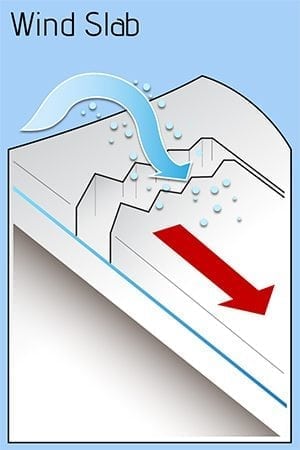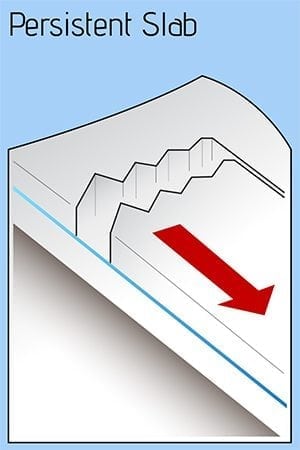Valdez
Above 3,000ftModerate
1,500 to 3,000ftModerate
Below 1,500ftModerate
The Avy Rose shows the forecasted danger by elevation and aspect. It adds more detail about where you are likely to find the dangers mentioned in the forecast. The inner circle shows upper elevations (mountain top), the second circle is middle elevations, and the outer circle represents lower elevations. Think of the Rose as a birds-eye view of a mountain, looking down from above. The rose allows our forecasters to visually show you which parts of the mountain they are most concerned about.
Degrees of Avalanche Danger
Avalanche Problems
Problem 1
The main stability concern today will be wind slabs on lee aspects (SE-NW). These will be possible to trigger in specific locations 1-2 feet in depth. Cross loaded gullies, the lee side of terrain features and lee of ridge lines will be the areas where windslabs exist. Windslabs may exist further down from ridge lines than you may expect due to the strength of the latest wind event. Pay attention to where winds have deposited slabs and investigate the depth and sensitivity in the area that you choose to travel to asses the hazard.
The hazard from this problem is decreasing as wind slabs stiffen and gain strength. New slabs have not been deposited on top of persistent grains (facets), which should allow them to stabilize at a normal rate(1-2 days).
Likelihood:
- Almost Certain
- Very Likely
- Likely
- Possible
- Unlikely
Size:
- Historic
- Very Large
- Large
- Small
Trend
- Increasing
- Steady
- Decreasing
Problem 2
Faceted snow near the base of the snowpack has been identified in all three forecast zones. In most locations above brush line, faceted snow is capped by pencil-knife hard wind affected snow. This has created a strong bridging affect making a person or machines weight unlikely to directly affect these layers.
Our area received 3-4 inches of snow water equivalent over a 5 day period beginning 12/11. This put significant stress on these weak layers. Natural avalanches did occur, but activity was not widespread and natural avalanches were mostly confined to the storm snow. This points to the strength of the wind hardened snow overlying the weak facets at the base of our snowpack.
It has been eight days since the last significant snowfall event, and stability tests that directly target these layers have not been producing significant results since. One exception was an interior location just north of our continental forecast zone where propagation in stability tests still existed on 12/18.
Persistent weak layers are tricky to assess and are notorious for surprising people. As long as temperatures remain cold and our snowpack is thin, these weak layers will continue to lose strength. It is likely that facets will reactivate in the future when stress is being applied through dramatic changes in weather such as: significant snow accumulation, rapid warming and wind loading. Maintaining safe travel protocols such as skiing one at a time and avoiding traveling in or above terrain traps will increase your safety margin.
The most likely areas to trigger a persistent slab avalanche would be in steep terrain that was protected from previous strong winds that have occurred this season. This could be below brushline or in areas of terrain that are typically spared from outflows. The Continental zone remains suspect as this area has a weaker snowpack and generally receives less wind, which would decrease the bridging affect mentioned above.
Likelihood:
- Almost Certain
- Very Likely
- Likely
- Possible
- Unlikely
Size:
- Historic
- Very Large
- Large
- Small
Trend
- Increasing
- Steady
- Decreasing
Avalanche Activity
Below is a summary of observed Avalanche activity from the last 7 days. Avalanches that were noted earlier in the season can be viewed by clicking the link below.
If you trigger or observe a natural avalanche consider leaving a public observation.
No recent avalanche activity has been recorded in the last 7 days.
Weather
Check out our updated weather tab! A collection of local weather stations are available for viewing with graphs and tabular data included.
NWS Watches and warnings
Northeast Prince William Sound- Including the cities of Valdez and Thompson Pass 351 AM AKST Sat Dec 24 2022 ...WIND CHILL ADVISORY REMAINS IN EFFECT UNTIL 1 PM AKST THIS AFTERNOON... * WHAT...Very cold wind chills. Wind chills as low as 45 below zero. Winds will still be gusty with gusts around 40 mph possible. Blowing snow is still expected with visibilities as low as 3/4 mile. * WHERE...Thompson Pass. * WHEN...Until 1 PM AKST this afternoon. * IMPACTS...The dangerously cold wind chills could cause frostbite on exposed skin in as little as 10 minutes. * ADDITIONAL DETAILS...Winds will continue to slowly diminish through the day. The coldest wind chill values are expected through Saturday morning.
NWS Point forecast for Thompson Pass
Date Saturday 12/24/22 Sunday 12/25/22 Time (LT) 06 12 18 00 06 12 18 00 06 Cloud Cover SC OV OV OV OV BK OV OV OV Cloud Cover (%) 45 70 85 85 75 55 95 95 90 Temperature -8 -5 -2 2 8 8 9 12 13 Max/Min Temp 0 -8 9 9 Wind Dir NE NE NE NE NE NE NE NE NE Wind (mph) 25 23 17 13 13 13 19 17 18 Wind Gust (mph) 46 42 40 34 32 35 42 40 36 Precip Prob (%) 5 30 60 60 5 5 30 60 60 Precip Type S S S S S S 12 Hour QPF 0.07 0.04 0.00 0.17 12 Hour Snow 0.0 0.6 0.0 2.0 Snow Level (kft) 0.0 0.0 0.0 0.1 0.2 0.0 0.0 0.0 0.0
Click on link below for Thompson Pass weather history graph:

| Date:
12/24 |
24 hr snow | HN24W* | High temp | Low temp | 72 hour SWE* | December snowfall | Seasonal snowfall | Snowpack Depth |
| Valdez | N/O | N/O | 18 | 10 | N/O | 50 | 85 | 38 |
| Thompson pass | 0 | 0 | 0 | -12 | .03 | 73 | 175 | 29 |
| 46 mile | 0 | 0 | 1 | -18 | N/O | ~22 | ~29** | 27 |
*HN24W- 24 hour Snow water equivalent in inches
*SWE– Snow water equivalent
**46 mile seasonal snowfall total begins December 1st.
Additional Information
Click on the link below for a running summary of this seasons weather history of our area.
Announcements
The avalanche hazard is moderate at all elevations. The main hazard today will be triggering a wind slab avalanche that could be 1-2 feet deep. Human triggered avalanches are possible in specific locations and natural avalanches are unlikely.
Posted by Gareth Brown 12/24 7:40 am.
For a description of current avalanche problems, weather information, season history and more click the (+ full forecast) button. Avalanche forecasts will be issued Wednesday-Sunday.

